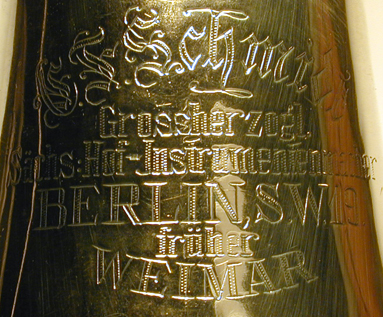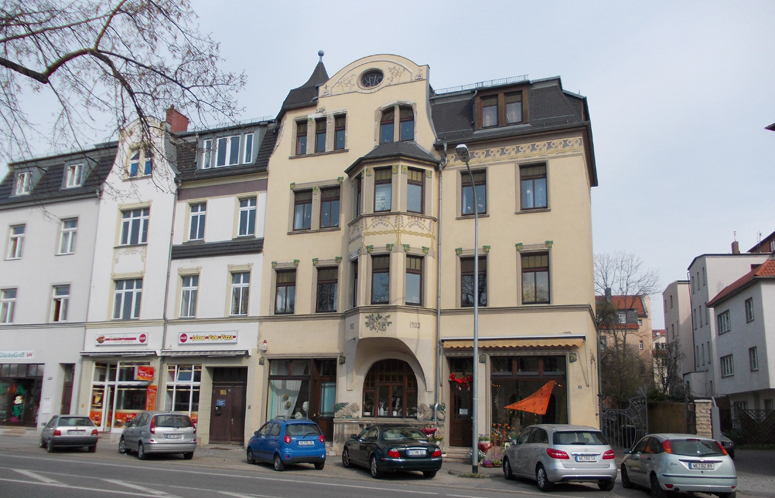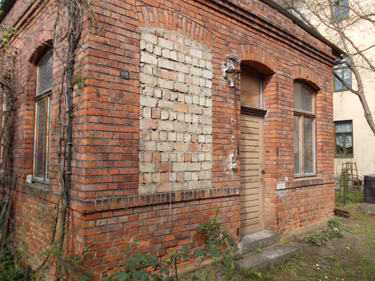| . (click on photos for larger view) |
|
 |
|
Carl Friedrich Schmidt (1852 - 1924) was born in Cologne on March 7, 1852, a son of brass instrument maker Friedrich Adolf Schmidt (1827 - 1893). He initially learned the craft of instrument making from his father, however it was common at the time for journeyman craftsmen to travel to study under masters in various cities to learn other production methods. His Wanderjahre included Erfurt where in 1876 he was named godfather to Johannes Kirchberg (1876 - 1961). While he was in Erfurt, Schmidt probably studied horn making with Eduard Kruspe. |
|
|
|
|


|
|
In 1900 Schmidt was working on the design of his double horn model. At the same time his godson, Johannes Kirchberg happened to be working a Firma Ed. Kruspe in Erfurt. Three years earlier Kruspe was granted D.R.G.M. 84240 for a double horn having tandem change valves conjoined by a rod and two-story main valves. The D.R.G.M. protected the design for only three years making it possible for Schmidt to use the two-story valves.2 Schmidt replaced the dual change valves with a single piston operated with the player's thumb. In the summer of 1900 while touring with the John Philip Sousa Band, Anton Horner visited the Schmidt workshop in Berlin:3To go a little farther with the development of the double horn, I must tell you that in 1900 I was engaged to go to the Paris Exposition, and to tour Europe with Sousa's Band... So even in Berlin, my reputation had spread, and Schmidt, the horn maker, who was first in Weimar, and now had his factory in Berlin, came to talk to me. He had invented a new B valve for a double horn, but could not decide what kind of mouthpiece tube was best for his new instrument. He asked me to come to his factory to help him decide. I went to his place, and after long trials of several mouthpiece tubes, I approved of one which he used on his first instruments in F an B. His B valve was a piston, like on a cornet, which I found very awkward to operate with the thumb.On April 1, 1916 C.F. Schmidt moved from Berlin back to Weimar as witnessed in Herr Schmidt's own hand:  Translation: |
|
 
Above left, the instrument label after the move to Weimar in 1919, with the reminder that the workshop was formerly in Berlin. At right, a later label where the Berlin years are now forgotten. Carl Fischer had been the sole authorized importer of C.F. Schmidt instruments into the U.S. and Canada since before the turn of the century. It is believed that Fischer was responsible for adding serial numbers which is useful for establishing a chronology. The phrase "Made in Germany" became required in 1930 as part of the Hawley-Smoot Tariff act and is also helpful in establishing the approximate date of manufacture. As noted in the above text, some instruments were marked "C.F. Schmidt & Co."between about 1924 and 1929, however that appears to be somewhat inconsistent. |
|
 C.F. Schmidt title for price list (ca. 1926), courtesy of Marco Rippert (click to see full price list) |
|
Carl Friedrich Schmidt specialized in the construction of horns. His double horn model dating from ca. 1899 and characterized by its bell profile and the Périnet F/B change valve, was widely used until the 1940s. He supplied instruments to various regiments and the orchestras of the court theaters in Weimar, Mannheim, Braunschweig, Dessau, Altenburg, Kassel, Coburg and Pest, as well as the St. Petersburg Conservatory. Later his instruments were exported as far away as Moscow, Amsterdam and Chicago, and for many years the Carl Fischer Company in New York became the "sole importer" of C.F. Schmidt instruments for the United States and Canada.It has since been built by other makers including SW Lewis, Karl Hill / Kortesmaki, George McCracken, and Yamaha Corporation model 863. |
|
 Weimar, Erfurter Straße 56 (formerly Nr.74) as it appears in 2014. It was built in 1903 and was the house of Rudolph Böhme with a workshop in the garden (below). From the early 1920s by the workshop was rented by C.F. Schmidt and used for making brass instruments. Operations continued here until the death of the last proprietor Johannes Kirchberg in 1961. |
|

 |
|
  (Photos by Marco Rippert, April 3, 2014) |
|
Johannes Kirchberg (1876 - 1961) was the last owner of C.F. Schmidt, Co. He was born on May 3, 1876 in Erfurt and was the godson of C.F. Schmidt with whom he later studied in Weimar from 1890 to 1893. After that he went to Köln for two years (1894 - 1896) working with Schmidt's younger brother L.A. Schmidt.4 Registration records show that he was in Braunschweig until December 2, 1899 when he moved back to his hometown, Erfurt, where he was employed by Firma Ed. Kruspe. He worked for Kruspe until August 14, 1900 when he returned to Weimar to work for C.F. Schmidt. His daughter, Anna Kirchberg (Bott), was born on October 19 1904 in Berlin where he had moved with Schmidt. In 1919 he and Schmidt moved the workshop from Berlin to Weimar where he became proprietor upon Schmidt's death in 1924. Meister Kirchberg was interviewed for ca. 1957 for a local newspaper (see below). He died on January 21, 1961 in Weimar. |
|
From the District of Weimar |
   Johannes Kirchberg Photos courtesy of Ludwig Bott and Marco Rippert |
|
|


